 W
WA 4th Dimension roller coaster is a type of steel roller coaster whereby riders are rotated independently of the orientation of the track, generally about a horizontal axis that is perpendicular to the track. The cars do not necessarily need to be fixed to an angle.
 W
WAn Accelerator Coaster is a hydraulically launched roller coaster model from Intamin. The model usually consists of a long, straight launch track, a top hat tower element, and magnetic brakes that smoothly stop the train without making contact. The technology was developed by Intamin engineers as an alternative to electromagnetic launch systems, such as the Linear Induction Motor (LIM) and Linear Synchronous Motor (LSM), that are found on earlier launched roller coasters like the Flight of Fear and The Joker's Jinx. Unlike the earlier linear induction motors, the Accelerator Coaster's launch system exhibits constant acceleration and is capable of reaching greater speeds.
 W
WA bobsled roller coaster is a roller coaster that uses a track design that is essentially a "pipe" with the top half removed and has cars that are sent down this pipe in a freewheeling mode. The name derives from the great similarity to the track design used for the winter sport of bobsleigh.
 W
WBoomerang is a model of roller coaster manufactured and designed by Vekoma, a Dutch manufacturer. The roller coaster model name is from the hunting implement based on the traditions of the Indigenous Australians. As of November 2021 there are 55 Boomerangs operating.
 W
WThe Booster is an amusement park ride made originally by HUSS Maschinenfabrik starting in 1998.
 W
WCentrifugal Railway was the name of a number of early looping roller coasters that were built in Western Europe in the middle of the 19th century. These rides were very similar in their basic design to many modern day shuttle roller coasters, but with only one lift hill and no launch. A single roller coaster car would ascend to the peak on the coaster before descending rapidly down the same hill and then passing through the central loop with enough speed and centrifugal force to remain on the track at the top of the loop. The size of these centrifugal railways differed; some were purported to have vertical loops of a mere 6.5 feet (2.0 m), while others were estimated to be 40 feet (12 m).
 W
WThe Condor is the trade name of an amusement ride sold by HUSS of Bremen, Germany. It was debuted at the 1984 New Orleans World's Fair, under the name "Cyclo Tower".
 W
WCorkscrew with Bayerncurve is a type of roller coaster that was manufactured by Vekoma. It was an adaptation of a similar corkscrew coaster designed by Arrow Development. The first model, Tornado, debuted in 1979 at Walibi Belgium. It was also the first roller coaster in mainland Europe to feature inversions.
 W
WThe Dive Coaster is a steel roller coaster model developed and engineered by Bolliger & Mabillard. The design features one or more near-vertical drops that are approximately 90 degrees, which provide a moment of free-falling for passengers. The experience is enhanced by unique trains that seat up to ten riders per row, spanning only two or three rows total. Unlike traditional train design, this distinguishing aspect gives all passengers virtually the same experience throughout the course of the ride. Another defining characteristic of Dive Coasters is the holding brake at the top of the lift hill that holds the train momentarily right as it enters the first drop, suspending some passengers with a view looking straight down and releasing suddenly moments later.
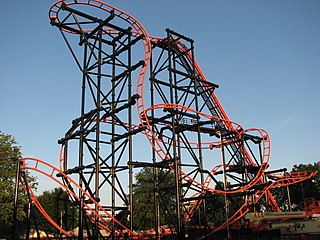 W
WEl Loco is a model of steel roller coaster manufactured by S&S Worldwide. The rides are characterised by a vertical or beyond-vertical drop, tight corners and abnormal banking. As of November 2013, there are six El Locos operating around the world.
 W
WThe Enterprise is an amusement ride, manufactured primarily by HUSS Park Attractions and Anton Schwarzkopf beginning in 1972. The HUSS ride was an adaptation and improvement of a design produced earlier that year by Schwarzkopf, with an increased passenger capacity. Despite not owning the original incarnation of the ride, HUSS was issued the patent.
 W
WThe Fire Ball is an amusement ride manufactured by Larson International. It replaced a series of Larson rides manufactured prior to its unveiling, the first being the Super Loops and the second being the Ring of Fire. Several variations of each exist. The rides run the same but the older models have a caged train, whereas the Fire Ball has an open face-off train. Also, some owners of the older Ring of Fire rides have had the caged train replaced with the new Fire Ball train.
 W
WA Floorless Coaster is a type of steel roller coaster manufactured by Bolliger & Mabillard where riders sit with no floor underneath them, allowing their feet to swing freely just above the track. Development of the Floorless Coaster model began between 1995 and 1996 with Medusa at Six Flags Great Adventure opening on April 2, 1999, making it the world's first Floorless Coaster. Floorless Coasters also tend to have 3 to 7 inversions incorporated in the layout of the coaster.
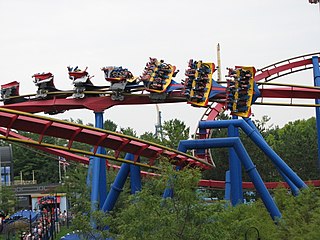 W
WThe Flying Coaster is a model line from Bolliger & Mabillard. It has produced 10 models in 18 years of production, one of the more average selling models in the company.
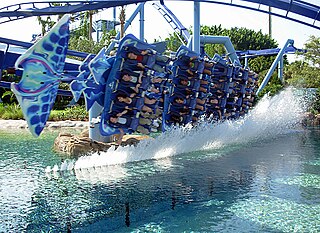 W
WA flying roller coaster is a type of roller coaster meant to simulate the sensations of flight by harnessing riders in a prone position during the duration of the ride. The roller coaster cars are suspended below the track, with riders secured such that their backs are parallel to the track.
 W
WFlying Turns is the name of a specific model of bobsled roller coaster. John Norman Bartlett, a British aviator in World War I, came to North America after the war with an idea for a trackless wooden chute, full of twists like a bobsled course, with toboggan-like cars, based on a bobsled ride that operated in Europe. He had filed GB Patent 279109A for the idea in 1926. Bartlett met John Miller in 1928, and they commenced building the new ride. When the ride went into production, much of the idea was the same, but the cars looks more like monoplanes, which Bartlett designed. Miller worked on the loading station, supporting structure, braking system and incline.
 W
WTranan is a suspended roller coaster located at Skara Sommarland amusement park in Sweden. The ride was manufactured by S&S Worldwide as the company's only Free Fly model, and it opened to the public in May 2009.
 W
WGalaxi is the common name of a series of mass-produced roller coasters manufactured primarily by Italian company S.D.C, which went bankrupt in 1993. The roller coaster design was first used in the 1970s, and as of 2009, sixteen Galaxi coasters are still in park-based operation, across the North American, European, and Australian continents, with another two "Standing But Not Operating". At least 37 amusement parks are or have previously operated Galaxi coasters; this does not include those owned by funfairs and traveling ride companies.
 W
WA Giant Inverted Boomerang is a type of steel shuttle roller coaster manufactured by the Dutch firm Vekoma. The ride is a larger, inverted version of Vekoma's popular Boomerang sit down roller coasters. As of November 2021, four installations of the model are operating, with another one under construction.
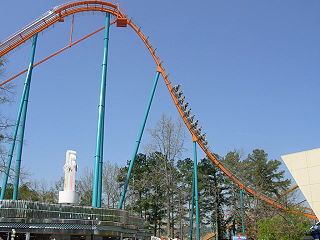 W
WThe Hyper Coaster is a model line from Bolliger & Mabillard. The company has produced 18 models over 21 years of production, making it one of the more successful models manufactured by the company.
 W
WAn Impulse roller coaster is a form of a launched inverted roller coaster manufactured by Intamin. The first Impulse roller coaster appeared in Japan, and the ride type has since evolved to include four specific layouts, three of these varieties being built in the United States. It uses LIMs to launch a train out of the station and up a vertical spiral. The train then falls backward, is powered again through the station, and heads up a back tower. The train then falls forward, and continues in this fashion for a total of 2½ cycles per ride. On the final forward launch, with a slightly reduced speed, the train is sent up the front tower, and brakes then deploy on the launch track. The train then slows down and heads back into the station.
 W
WAn inverted roller coaster is a roller coaster in which the train runs under the track with the seats directly attached to the wheel carriage. This latter attribute is what sets it apart from the older suspended coaster, which runs under the track, but swings via a pivoting bar attached to the wheel carriage. The coaster type's inverted orientation, where the passengers' legs are exposed, distinguishes it from a traditional roller coaster, where the passengers' arms are instead exposed.
 W
WInvertigo is the name of an inverted shuttle roller coaster model developed and manufactured by Dutch company Vekoma. Four roller coasters based on this model were built, with the first installation opening in 1997 as HangOver at Liseberg amusement park located in Sweden. Three of the four are still in operation. Invertigo is designed as an inverted variation of their traditional Boomerang model, which first appeared in 1984. Invertigo's seat configuration is also a departure from its predecessor, in that riders sit back-to-back, resulting in all rows facing one another with the exception of the first and last.
 W
WA Launched Loop is a type of steel launched shuttle roller coaster manufactured by Arrow Dynamics. With 8 different installations, 7 of them being relocated at least once, the ride was introduced in 1977, with the last one opening in 1993.
 W
WThe Looping Starship is an amusement ride manufactured by Intamin of Switzerland. The ride is a swinging ship that can spin a complete 360-degree revolution. The ride has been modified with custom theming to resemble a number of different vehicles, including a Space Shuttle, a fighter jet, an Egyptian cargo ship, and a Looney Tunes ACME Rocket.
 W
WA mine train roller coaster is a steel roller coaster whose trains often depict a set of mine carts, with the forward-most car or portions of it sometimes resembling a small steam locomotive. Most mine train roller coasters are themed in the style of a mine, a Western scene, or simply a mountain range.
 W
WA motorbike roller coaster is a type of steel roller coaster designed with motorcycle type cars. Booster Bike at Toverland was the world's first motorbike roller coaster. Vekoma was the first company to design such a ride, although Intamin and Zamperla have since created similar designs.
 W
WThe Pipeline Coaster is a roller coaster model where the trains ride between the tracks as opposed to a traditional roller coaster where they ride above them. The concept was first developed by Japanese ride company TOGO, and was known as the Ultra Twister. They built six installations of the design, and four are still in operation. Arrow Dynamics created an alternate version of the concept, but it never made it past the prototype stage in development. Intamin also experimented with the pipeline concept and built and relocated one model, known as the Spiral Coaster, but it is no longer operating. Some of the drawbacks of the design include the need for large, uncomfortable over-the-shoulder restraints as well as the obstruction of the riders' view by the enclosed pipe structure.
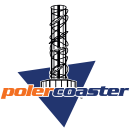 W
WPolercoaster is a type of amusement ride offered by US Thrill Rides and Intamin. An installation consists of a large tower structure which features glass elevators to an observation deck, as well as a steel roller coaster wrapping around the tower. The model was first introduced in 2012, and as of November 2013, four have been proposed for construction. However, none have been constructed as of 2021.
 W
WRainbow is an amusement park ride created by HUSS Maschinenfabrik of Bremen, Germany. The Rainbow was manufactured from 1982 to 2000 and is often confused with its cousins Ali Baba and 1001 Nachts, which are quite different. The HUSS Rainbow has developed a vast fan base due to its large stature, smooth ride, bright lights, and iconic motor noise.
 W
WA Ranger is an inverting pendulum ride first manufactured by HUSS Machinenfabrik in 1981. Many of the design elements were later used in the HUSS Rainbow, and the term 'Ranger' has become synonymous with inverting pendulum rides. It was the first inverting swing ride designed since Lee Eyerly's Loop-O-Plane and set the standard for many other attractions using the inverting pendulum ride system, such as the Rainbow, the Kamikaze (ride), and the Inverter.
 W
WThe Roll-O-Plane also known as the Bullet is an amusement park ride that originated in America. It was invented by the Eyerly Aircraft Company of Salem, Oregon, as an updated and more exciting version of the Loop-O-Plane. The ride is commonly nicknamed the "Salt and Pepper Shakers".
 W
WScreamin' Swing is a pneumatically powered pendulum ride designed and manufactured by S&S - Sansei Technologies. The ride was first installed and operated in 2004 at Knott's Berry Farm in Buena Park, California, United States.
 W
WShuttle Loop is a type of steel launched shuttle roller coaster designed by Reinhold Spieldiener of Intamin and manufactured by Anton Schwarzkopf. A total of 12 installations were produced between 1977 and 1982. These 12 installations have been located in a total of 22 different amusement parks.
 W
WSky Rocket II is a steel roller coaster model made by American manufacturer Premier Rides. The first Sky Rocket II was Superman: Ultimate Flight at Six Flags Discovery Kingdom, which opened on June 30, 2012, and the latest is Tigris at Busch Gardens Tampa in 2019. The ride model features a height of 150 feet (46 m), a length of 863 feet (263 m), a maximum speed of 62 miles per hour (100 km/h), and includes one inversion. The ride has been noted for its low-cost and small foot-print.
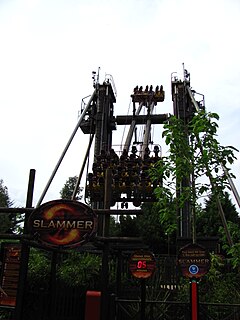 W
WThe Sky Swatter was a thrill ride which was built by S&S Power of Logan, Utah. It was marketed from 2003 to 2010; only two Sky Swatters were manufactured. The first installation of a Sky Swatter was as SWAT at Six Flags AstroWorld in Houston, Texas, which operated from 2003 until the park permanently closed at the end of the 2005 season. The ride then was moved to Six Flags New England and operated from 2006 through 2012 as Catapult. The other Sky Swatter operated as Slammer at Thorpe Park from 2005 until the ride closed permanently in May 2017.
 W
WSkyLoop is a type of steel roller coaster manufactured by Maurer Söhne. There are currently 10 SkyLoops operating worldwide, nine of which are identical XT 150 models, and one of which is an extended XT 450 model. The first SkyLoop to open was Sky Wheel in 2004 while the sole XT 450, Abismo, opened in 2006. There are also three other models available—XT 900, Custom, and Launch—which have not seen any installations as of 2021.
 W
WSpace Shot is a type of amusement ride manufactured by S&S - Sansei Technologies.
 W
WA stand-up roller coaster is a roller coaster designed to have the passengers stand through the course of the ride.
 W
WA Suspended Family Coaster is a steel inverted roller coaster built by Vekoma designed for families with no inversions. Just like all inverted roller coasters the train runs under the track with the seats directly attached to the wheel carriage. This latter attribute is what sets it apart from the older suspended swinging coaster, which runs under the track, but "swings" via a pivoting bar attached to the wheel carriage.
 W
WThe Suspended Looping Coaster is a model of steel inverted roller coaster built by Vekoma. There are at least 39 different installations across the world. The minimum rider height requirement is 130 centimetres. Vekoma is now marketing a Suspended Thrill Coaster as a successor to the Suspended Looping Coaster. The Odyssey is the largest, fastest and tallest SLC ever built at Fantasy Island in the UK.
 W
WA suspended roller coaster is a type of steel roller coaster in which the car hangs from the bottom of the rolling stock by a pivoting fulcrum or hinge assembly. This allows the car and riders to swing side to side as the train races along the track. Due to the swing designs, these roller coasters cannot invert riders.
 W
WThe UFO is an amusement park ride designed by HUSS Maschinenfabrik in 1978, based on the company's Enterprise and Skylab amusement rides. Numerous carnivals feature this ride which is known as Alpha One Peeters and Vertical Limits.
 W
WThe Vekoma Junior Coaster is a model of steel roller coaster built by Vekoma. It is commonly referred to as a Roller Skater due to the roller skate shaped cars found on some of the installations.
 W
WA Water Coaster is a steel roller coaster that combines roller coaster elements, such as chain lift hills and steep drops, with boat-based attraction elements, such as splash-down landings.
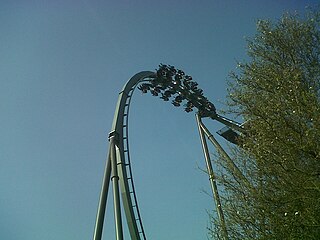 W
WWing Coaster is engineering firm Bolliger & Mabillard’s designation for its winged roller coaster designs. Winged roller coasters are a type of steel roller coaster where pairs of riders sit on either side of a roller coaster track in which nothing is above or below the riders. B&M began development on the first Wing Coaster between 2007 and 2008 leading to the opening of Raptor at Gardaland on 1 April 2011. There are currently sixteen B&M-designed Wing Coasters either under construction or operating worldwide as of December 2020.